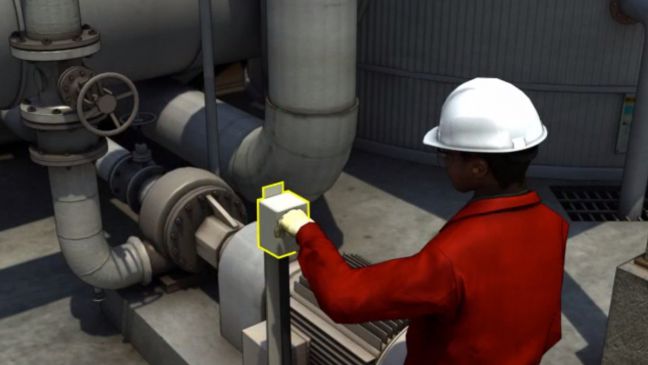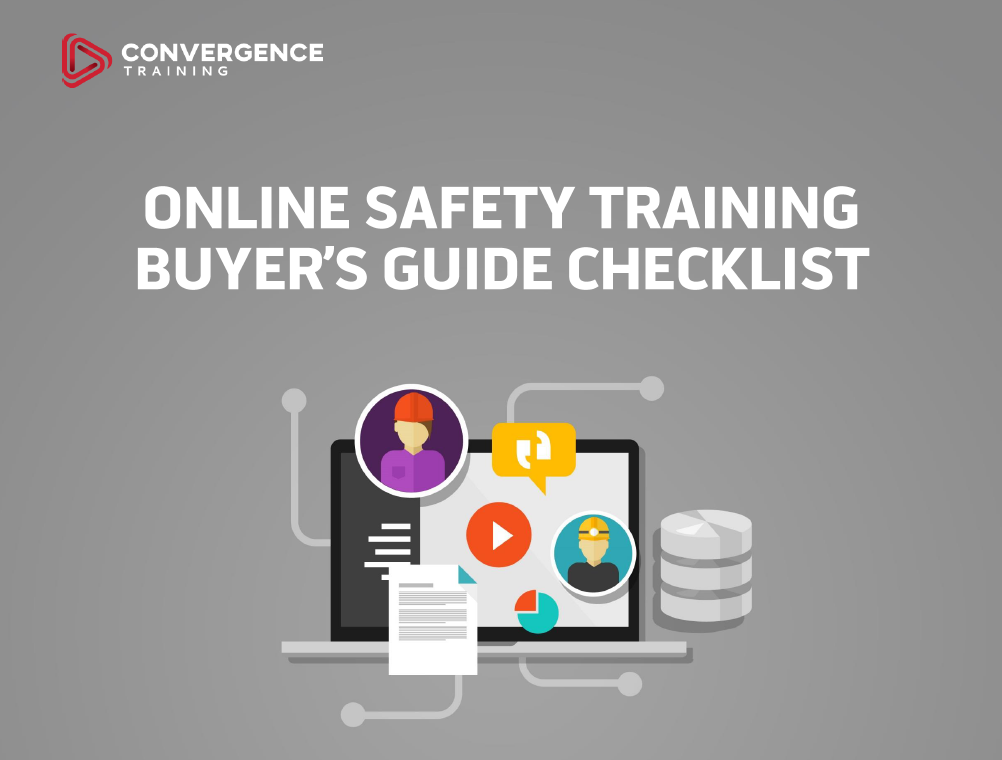
LOTO stands for lockout/tagout. When done properly before equipment service or maintenance, lockout/tagout procedures control hazardous energy and protect workers from harm.
In this article, we’ll look at the basics of lockout/tagout and LOTO safety. This will include some basic definitions, relevant OSHA regulations and informational resources, and steps to follow when performing lockout.
In addition to this article, you may find some of our other LOTO articles and resources instructive and even fun. These include:
- Lockout/Tagout Word Game for Authorized Employees
- Lockout/Tagout Word Game for Affected Employees
- Lockout/Tagout Information Resources
- Learning Management Systems
- Online Safety and Health Training Courses
- EHS & Safety Management Software
- Mobile Apps for Safety Management and Safety Training
The Purpose of Lockout/Tagout and LOTO Safety
When machines or equipment are being prepared for service or maintenance, they often contain some form of “hazardous energy” that can cause harm to people in the area.
When we talk about hazardous energy, we mean any type of energy that can be released and might harm a person. This could include energy of the following types:
- Chemical
- Electrical
- Hydraulic
- Mechanical
- Pneumatic
- Thermal
- Other sources of energy
Without the use of proper LOTO safety procedures, the serviced equipment can unexpectedly start up or otherwise release these forms of energy. This can lead to injuries and even death to the people working on the machine and even to others working in the area or living in the community.
Energy sources including electrical, mechanical, hydraulic, pneumatic, chemical, thermal, or other sources in machines and equipment can be hazardous to workers. During the servicing and maintenance of machines and equipment, the unexpected startup or release of stored energy can result in serious injury or death to workers.
Consider just a few examples:
- A worker is servicing a press, another worker comes by and starts the press, and the service worker is caught up in the press, causing an amputation
- Workers are repairing a connection in piping, and somewhere up that same line another worker opens a valve, sending fluids down the pipe that ultimately spill on and burn the maintenance workers
- A conveyor jams, a worker reaches in to try to clear the jam, the conveyor jam is suddenly and unexpectedly freed, and the worker is crushed as a result
- A worker is servicing a machine, and at the same time internal wiring in the machine shorts, causing the maintenance worker to be shocked
All of these are examples of hazardous energy causing harm. And that’s what LOTO safety is all about–making these these types of hazardous energy are controlled so they’re never released and never cause harm.
Lockout/Tagout is Part of an Energy Control Program
Every workplace should have an energy control program in place, with LOTO safety being one part of that program. An energy control program includes established procedures for using locks and tags; the locks and tags themselves; training workers on hazards of hazardous energy and lockout/tagout procedures, policies, and equipment; and periodic reviews and inspections of the system (at least annually).
Here are three good resources to help you develop your own workplace energy control program:
- NIOSH, Guidelines for Controlling Hazardous Energy During Maintenance and Servicing
- Texas Department of Insurance, Sample Written Program for Control of Hazardous Energy
- Maine Department of Labor, Control of Hazardous Energy Sample Program
NOTE: for the two sample programs listed above, click our link, then scroll down a bit, look for corresponding link, and download the Word document.
The OSHA General Industry standard that covers all this is 1910.147, The Control of Hazardous Energy (Lockout/Tagout). OSHA has also prepared this great list of resources related to hazardous energy control as well as this Lockout/Tagout eTool.
Plus you might enjoy some of these lockout-/tagout resources:
- Fun Lockout-Tagout Safety Training Word Game (Authorized Employees)
- Fun Lockout-Tagout Safety Training Word Game (Affected Employees)
- Helpful Lockout-Tagout Information
- Interactive Lockout-Tagout Glossary
Six Steps of LOTO Safety & Lockout/Tagout Procedures
A lockout/tagout procedure should include the following six steps:
- Preparation
- Shutdown
- Isolation
- Lockout/tagout
- Stored energy check
- Isolation verification
Let’s look at each of these steps of LOTO safety more closely in the sections below.
Lockout/Tagout Step 1: Preparation
The first step of locking and tagging out equipment for service and maintenance is to prepare.
During the preparation phase, the authorized employee must investigate and gain a complete understanding of all types of hazardous energy that might be controlled. In addition, it’s important to identify the specific hazards and of course means for controlling that energy.
Use this Guide to Types of Hazardous Energy to investigate this issue more fully.

Lockout/Tagout Step 2: Shut Down
With planning complete, the actual process of powering down and locking out machines begins.
At this point, it’s time to shut down the machine or equipment that will be serviced or maintained.
Another important part of this step is to inform any employee affected by the shutdown, even if they won’t play a role in the service or maintenance.

Lockout/Tagout Step 3: Isolation
The next step of the lockout/tagout procedure is to isolate the machine or equipment from any source of energy.
This may mean any number of things, such as turning off power at a breaker or shutting a valve.

Lockout/Tagout Step 4: Lockout/Tagout
With the machine or equipment isolated from its energy source the next step of lockout/tagout is to actually lock and tag out the machine. It’s fair to say that this entire six-step process takes its name from this step.
During this step, the authorized employee will attach lockout and/or tagout devices to each energy-isolating device. The point is to apply the lockout device on the energy-isolating device in a way so it says in the “safe” position and cannot be moved to the unsafe position except by the person performing the lockout.
Tagout refers to applying a tag on the device as well. This tag includes the name of the person who performed the lockout and additional information.

Lockout/Tagout Step 5: Stored Energy Check
Even after the energy source has been disconnected, in step 3 of the lockout safety process, and the machine has been locked out, in step 4, that doesn’t entirely guarantee that there’s no hazardous energy still stored within the machine or that it’s safe to perform maintenance.
At this time, it’s important to look for any hazardous energy that’s been “stored” within the machine, or any “residual” energy. During this phase, any potentially hazardous stored or residual energy must be releived, disconnected, restrained, or made non-hazardous in some other way.

Lockout/Tagout Step 6: Isolation Verification
This last step is all about making sure.
Yes, you’ve shut down the machines, isolated them from their source of power, locked them out, and checked for hazardous stored energy. But now’s the time to double-check that you did it all right and it’s now safe to work on the machine or equipment.
At this point, an authorized employee verifies the machine has been properly isolated and de-energized.

The example images shown above are all from one of our two online Lockout-Tagout training courses. We have one for Affected Employees and a second for Authorized Employees. Click those links to learn more and see a sample about each online lockout course, and/or watch the short sample video below from our Lockout Training for Authorized Employees course.
Conclusion: LOTO Safety in 6 Easy Steps
We hope you enjoyed and perhaps learned a bit from our LOTO safety blog post, and its listing of the six basic steps of every lockout/tagout procedure.
Please do check out the additional lockout/tagout articles, word games, and more that we provided at the top of this article, and don’t forget to check out our online lockout/tagout training courses as well.
At some point in the near future, we think we’ll write more articles about lockout/tagout and LOTO safety, including a fuller explanation of the authorized and affected employee role, a look at lockout/tagout hardware, what to do in group LOTO situations, and more. If you’ve got some questions about lockout/tagout, let us know and we’ll see if we can address them for you.
And before you go, please DOWNLOAD THE FREE ONLINE SAFETY TRAINING BUYER’S GUIDE CHECKLIST, BELOW.

Online Safety Training Buyer’s Guide Checklist
Learn how to evaluate the different online safety training solutions that exist to find one that best fits your company’s needs with our FREE informative guide and checklist.
I am looking for some good services for LOTO recommendations, training and possibly audits for a new brewery in Mozambique.
Ebi, congrats on the new brewery, first! Very cool. Good luck with it.
We have courses for lockout/hazardous energy control here: https://www.convergencetraining.com/lockout-and-energy-control-courses.html
We don’t do in-person training on lockout, though perhaps some folks in your area do, and we don’t create lockout procedures, though again perhaps some folks in your area do. We wish you luck with those two components, and if you use our lockout training courses, we’re sure those will be a help.
Thanks for reading/writing to us.
Best wishes,
Jeff and Convergence Training
Hi Ebi,
We are a Cameroonian company with many years of experience in providing HSE services in process industry including energy isolation and LOTO. You can send me an email to my personal account (aimar.bogne@gmail.com or aimar_bogne@yahoo.fr) and I will put you in contact with our technical department for more details.
Regards,
Aimar Bogne, MEng.
HSE Consultant/Lecturer